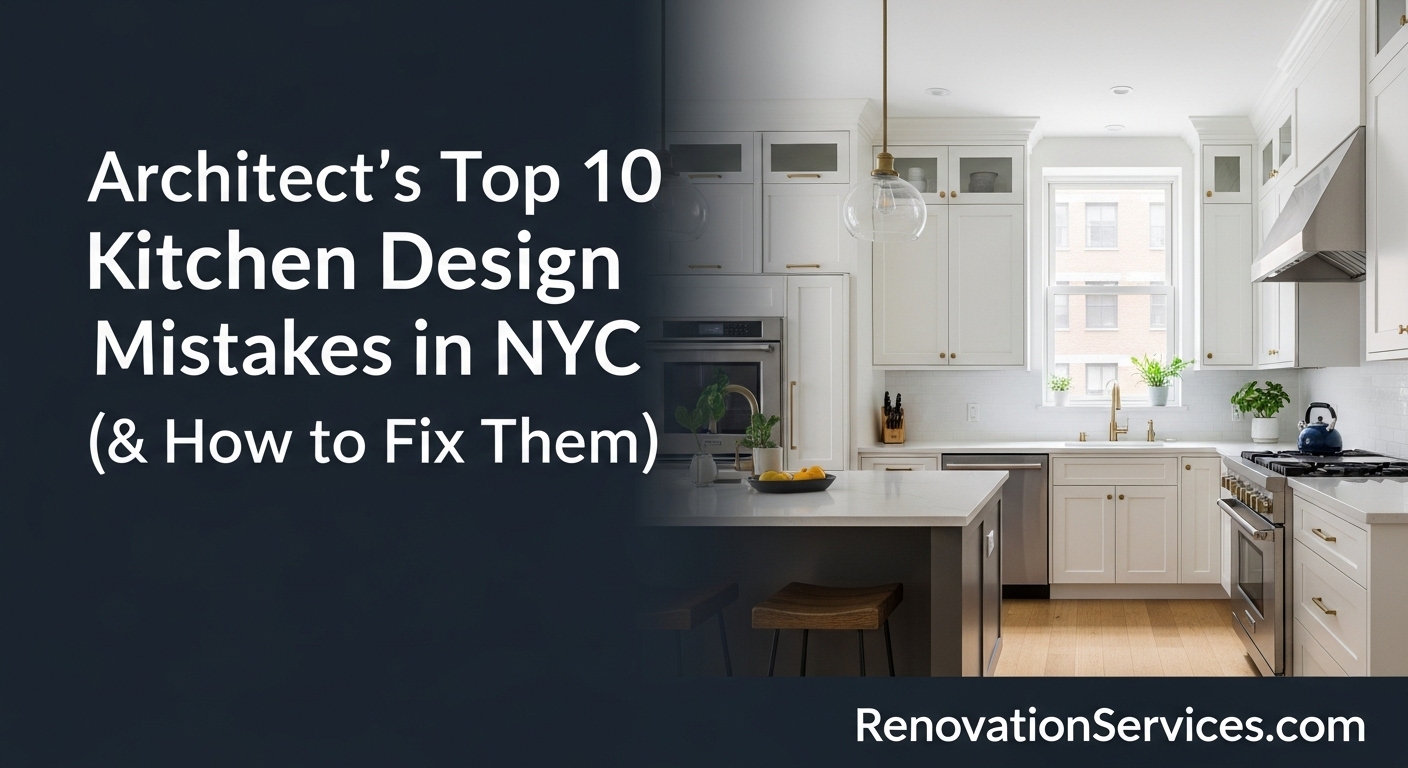N.Y. Renovation Services
Architect’s Top 10 Kitchen Design Mistakes in NYC (& How to Fix Them)

Embarking on a kitchen renovation in New York City is one of the most exciting and valuable investments you can make in your home. Whether you’re overhauling a galley kitchen in a Manhattan co-op or reimagining the heart of your Brooklyn brownstone, the dream is a space that is both beautiful and supremely functional. However, the path to that dream kitchen is paved with potential pitfalls. Even small design mistakes can lead to daily frustrations and costly corrections.
To help you navigate this complex process, we’ve distilled an architect’s expert advice on the most common—and often overlooked—kitchen design mistakes. From inefficient storage to poor lighting, these are the errors that can compromise the joy and utility of your new kitchen. This guide will not only identify these top 10 mistakes but also provide practical, NYC-specific solutions to fix them, ensuring your investment results in a kitchen you’ll love for years to come. If the project feels overwhelming, the experts at RenovationServices.com are always ready to bring professional architectural insights to your kitchen remodel.
1. The Storage Showdown: Underusing Drawers
The Mistake: Defaulting to Cabinets Over Drawers
The most common mistake in kitchen storage design is prioritizing standard lower cabinets with doors over deep, functional drawers. While cabinets might seem traditional, they are fundamentally inefficient. Reaching for a pot, pan, or stack of plates at the back of a deep cabinet requires you to get on your knees and pull everything else out first. This daily annoyance is a classic sign of poor ergonomic design.
The NYC-Specific Challenge
In a typical Queens apartment or Long Island home, kitchen space is a precious commodity. Every square inch of storage must be maximized for accessibility and efficiency. A 70 to 100-square-foot galley kitchen simply cannot afford to have “dead zones” at the back of cabinets. The argument that drawers are more expensive—due to hardware and multiple fronts—often leads homeowners on a tight budget to choose the less functional option, a decision they almost always regret.
The Architect’s Fix: Prioritize Full-Extension Drawers
The solution is to dedicate the majority of your lower cabinetry budget to high-quality, full-extension drawers.
- Total Accessibility: Full-extension drawer slides allow the entire drawer to pull clear of the cabinet, giving you an unobstructed, top-down view of everything inside. No more lost items in the dark recesses.
- Heavy-Duty Hardware: Modern drawer hardware is incredibly robust, capable of holding 75-100 pounds or more. This means you can confidently store heavy items like stacks of ceramic plates, cast-iron skillets, and small appliances like stand mixers.
- Organizational Bliss: Drawers are far easier to organize. With simple peg systems or custom dividers, you can create designated spots for pots, lids, dishes, and pantry staples, preventing them from becoming a jumbled mess.
Avoid This Sub-Mistake: Steer clear of “concealed drawers” hidden behind a large cabinet door. This design compounds the problem by requiring two actions to access your items (opening the door, then pulling the drawer) and often requires the cabinet door to be open a full 90 degrees or more, creating a traffic jam in a narrow NYC kitchen.
2. The Push-to-Open Problem: A Handleless Headache
The Mistake: Choosing Form Over Function with Push-Close Hardware
The desire for a sleek, minimalist aesthetic often leads designers and homeowners to opt for handleless cabinets with push-to-open mechanisms. These systems use a spring-loaded latch that pops the door open when you press on it. While the look is undeniably clean, the daily user experience can be intensely frustrating.
The NYC-Specific Challenge
In a high-traffic, multi-person household, the inability to simply swing a cabinet door shut with your hip or elbow while your hands are full is a significant drawback. You must consciously push the door until the magnetic or mechanical latch engages. More often than not, doors are left slightly ajar, completely ruining the intended minimalist look. Furthermore, these systems turn your beautiful cabinet fronts into a canvas of fingerprints, especially on matte or dark finishes, requiring constant wiping down—a chore no busy New Yorker needs.
The Architect’s Fix: Smarter Handleless Solutions
You can achieve a clean, handleless aesthetic without sacrificing functionality.
- Integrated Finger Pulls: The best professional solution is an integrated or rebated finger pull. This involves creating a channel along the top or side edge of the door or drawer front, allowing you to hook your fingers behind it to pull it open. It’s invisible from the front but perfectly functional.
- Extended Fronts: For upper cabinets, simply designing the door to hang an inch below the cabinet box allows you to grab it from the bottom. This is a simple, cost-effective solution.
- Channel Systems: High-end modern kitchens often use a continuous metal channel installed between drawers or behind doors, creating a gap for your hands. This provides the handleless look with superior ergonomics.
3. Shadow Play: Incorrect Spotlight Placement
The Mistake: Relying Solely on Central Ceiling Lights
A common lighting error is placing a grid of recessed spotlights (or a single fixture) in the center of the kitchen ceiling. The assumption is that this will provide even, overall illumination. In reality, it does the exact opposite for your most critical areas.
The NYC-Specific Challenge
When you stand at your countertop to chop vegetables or read a recipe, your body is positioned directly between the central ceiling light and your work surface. This casts your own body’s shadow directly onto your hands and the task at hand, making it difficult to see clearly and creating a frustrating work environment. In a compact NYC kitchen, where every inch of counter space is vital, proper illumination is not a luxury—it’s a necessity for safety and efficiency.
The Architect’s Fix: Layer Your Lighting with a Focus on Task
The key to a well-lit kitchen is a layered approach, with task lighting as the hero.
- Under-Cabinet LED Strips: This is the single most important piece of kitchen lighting. Installing continuous LED strips on the underside of your upper cabinets floods your countertops with bright, shadow-free light exactly where you need it. It makes food prep safer and easier.
- Pendant Lights: Over a kitchen island or peninsula, pendants provide both task lighting and a powerful design statement. Ensure they are hung at a height that illuminates the surface without obstructing views.
- Sconces: Wall sconces can add a warm, ambient layer of light and are perfect for highlighting a feature wall or a small breakfast nook.
- Smarter Recessed Lighting: If using recessed lights, position them closer to the edge of the countertops, not in the central walkway. This way, they illuminate the front of the cabinets and the floor, contributing to ambient light without creating shadows on your workspace.
4. The Door Dilemma: Impractically Wide Cabinet Doors
The Mistake: Specifying Single, Wide Doors on Upper Cabinets
In an effort to save on costs or achieve a certain look, homeowners might opt for a single, wide cabinet door (e.g., one 30-inch door) instead of two smaller doors (e.g., two 15-inch doors). While it seems like a minor detail, it has major implications for usability.
The NYC-Specific Challenge
In the tight confines of a typical city kitchen, a wide-swinging cabinet door becomes a head-level hazard. Imagine unloading the dishwasher: you open the upper cabinet to put away glasses, and now there’s a large door sticking out right in the main path. If your partner or a child walks through, it’s an accident waiting to happen. It creates a constant obstruction, forcing you to duck and weave in your own workspace.
The Architect’s Fix: Use Double Doors or Smarter Hinges
Functionality and safety should always trump minor cost savings.
- Opt for Double Doors: The simplest solution is to always specify two smaller doors for any upper cabinet wider than 24 inches. A 15-inch door projects much less into the space than a 30-inch door, making the kitchen safer and more pleasant to work in.
- Consider Lift-Up Systems: For a more modern approach, use lift-up hinge systems. These allow the cabinet door to pivot up and out of the way, keeping the path completely clear. They are more expensive but offer unparalleled access and safety in a narrow galley kitchen.
5. Appliance Overload: When Bigger Isn’t Better
The Mistake: Forcing Oversized Appliances into a Small Footprint
It’s easy to get seduced by a professional-grade 36-inch range or a large French-door refrigerator with all the latest features. However, forcing oversized, standalone appliances into a kitchen that can’t comfortably accommodate them is a critical design error. It throws off the scale of the entire room, eats up valuable counter and storage space, and disrupts the flow.
The NYC-Specific Challenge
This is perhaps the most common mistake in NYC kitchen renovations. Homeowners moving from a larger suburban home to a Staten Island house or trying to fit their dream appliances into a pre-war Brooklyn apartment often underestimate the impact of scale. An oversized appliance can make a kitchen feel cramped and look disjointed. Furthermore, getting that massive appliance delivered and installed through narrow hallways and doorways can be a logistical and costly nightmare.
The Architect’s Fix: Embrace Right-Sized and Integrated Appliances
A well-designed kitchen respects the proportions of the space.
- Choose Compact, High-Performance Models: Many high-end brands now offer “apartment-sized” appliance packages (e.g., 24-inch refrigerators, 18-inch dishwashers, 24-inch ranges) that provide premium features without the massive footprint.
- Prioritize Integrated, Panel-Ready Appliances: The ultimate solution for a seamless look is to use integrated, panel-ready appliances. By covering your refrigerator and dishwasher with custom panels that match your cabinetry, they disappear into the design, creating a clean, uncluttered, and visually larger space. This is a hallmark of high-end Manhattan kitchen design.
- Be Honest About Your Needs: Do you really need a six-burner range if you typically only use two? Be realistic about your cooking habits and choose appliances that fit your lifestyle, not just your aspirations.
6. The Accessibility Gap: Wasted High and Low Spaces
The Mistake: Ignoring the Hard-to-Reach Zones
Standard kitchen design often leaves the highest shelves of upper cabinets and the lowest parts of base cabinets as difficult-to-access “dead zones.” Items stored here are often forgotten or require a step stool and significant effort to retrieve, rendering the space functionally useless for daily items.
The NYC-Specific Challenge
In a city where every square foot can cost a premium, wasting storage is not an option. A well-designed kitchen must make every cubic inch work hard. This is especially true in kitchens with high ceilings, common in lofts and pre-war buildings, where the vertical space is abundant but often underutilized.
The Architect’s Fix: Incorporate Smart Storage Mechanisms
Modern cabinet hardware offers brilliant solutions to conquer these accessibility gaps.
- Pull-Down Shelving: For upper cabinets, pull-down shelving systems are a game-changer. These mechanisms allow a whole shelf (or two) to pull down and out, bringing the contents to a comfortable, accessible height. They are perfect for storing spices, glasses, or other frequently used items.
- Deep Drawers for Base Cabinets: As mentioned in the first point, deep drawers are the ultimate solution for lower cabinets. They eliminate the need to kneel and reach into a dark void.
- Vertical Dividers: For items like baking sheets, cutting boards, and serving platters, install vertical dividers in a base cabinet. This allows you to slide items in and out easily without having to unstack them.
- Appliance Lifts: For heavy appliances like a stand mixer or blender, an appliance lift mechanism installed in a base cabinet can swing the appliance up to counter height, saving you from heavy lifting and keeping your countertops clear.
7. The Power Shortage: Insufficient Outlets
The Mistake: Not Planning for Enough Electrical Outlets
One of the most frustrating and surprisingly common mistakes is underestimating the number of electrical outlets needed in a modern kitchen. Homeowners often place only one or two outlets along a backsplash, leading to a constant shuffle of unplugging the toaster to use the coffee maker or running extension cords across countertops—an unsafe and unsightly practice.
The NYC-Specific Challenge
NYC’s electrical code has specific requirements for outlet placement in kitchens, including that no point along a countertop wall space be more than 24 inches from an outlet. Adhering to this code is not just about compliance; it’s about functionality. In a city where countertop appliances—from espresso machines to air fryers—are a way of life, having ample, conveniently located power is essential. Renovating electrical systems in a co-op or condo can also be complex, involving permits and licensed electricians, so it’s critical to get it right the first time as detailed in our guide to navigating NYC renovation permits.
The Architect’s Fix: Plan for Power Everywhere
Think about how you use your kitchen and plan your outlets accordingly.
- Double Up on Outlets: Install more outlets than you think you’ll need. Placing double-gang outlets every four feet along the backsplash is a good rule of thumb.
- Island and Peninsula Power: If you have an island or peninsula, incorporating outlets on the side is a must. This is perfect for using laptops, charging phones, or plugging in small appliances.
- Under-Cabinet Power Strips: For a completely seamless backsplash, consider installing a power strip along the underside of your upper cabinets. This hides the outlets from view while keeping them perfectly accessible.
- Appliance Garages: Plan for outlets inside your “appliance garage” or pantry cabinet to keep your toaster, blender, and coffee maker plugged in and ready to use but out of sight.
8. Material Missteps: Forgetting Durability & Maintenance
The Mistake: Prioritizing Aesthetics Over Practicality
Falling in love with a material’s look without considering its real-world performance is a recipe for long-term frustration. A beautiful but porous marble countertop that stains easily or a trendy but hard-to-clean backsplash can become a source of constant worry and maintenance.
The NYC-Specific Challenge
The intensity of NYC living extends to our kitchens. They are high-traffic, high-use zones. Materials must be robust enough to handle daily cooking, spills, and entertaining. A delicate material that requires constant sealing or special cleaners may not be practical for a busy family in Riverdale or a couple who loves to host dinner parties in their SoHo loft.
The Architect’s Fix: Choose Materials That Marry Beauty and Brawn
Select materials based on a balance of aesthetics, budget, and, most importantly, lifestyle.
- Countertops: While marble is beautiful, it’s porous and can etch and stain. For a similar look with superior durability, consider engineered quartz or quartzite. They are non-porous, scratch-resistant, and require no sealing. For an industrial look, stainless steel is virtually indestructible, while butcher block adds warmth but requires regular oiling.
- Cabinet Finishes: As discussed in our guide to the best cabinet paints, a high-quality urethane enamel provides a hard, scrubbable surface. For handleless designs, a satin or textured laminate finish will hide fingerprints far better than a high-gloss or dark matte finish.
- Backsplash: A large slab of quartz or a back-painted glass panel offers the easiest cleaning with no grout lines. If you love tile, choose a larger format tile to minimize grout and use a high-performance, stain-resistant epoxy grout.
- Flooring: Durability is key. Porcelain tile is extremely hard and water-resistant. Luxury vinyl tile (LVT) offers excellent water resistance and is softer underfoot. While beautiful, solid hardwood can be prone to water damage and may not be ideal for every kitchen.
9. The Workflow Flaw: Inadequate Landing Space
The Mistake: Not Planning for Countertop “Landing Zones”
A functional kitchen is all about flow. A major mistake is failing to provide adequate counter space on either side of key work zones—the sink, the cooktop, and the refrigerator. This creates a clumsy and inefficient workflow, forcing you to carry hot pots, wet dishes, or heavy groceries across the kitchen to find a place to set them down.
The NYC-Specific Challenge
In a compact kitchen, every inch of countertop is prime real estate. It’s tempting to cram in an extra-large sink or a wider range, but doing so at the expense of landing space is a critical error. The classic “work triangle” (the path between sink, stove, and fridge) is the foundation of ergonomic kitchen design. Without proper landing zones, this triangle breaks down, leading to inefficiency and potential safety hazards.
The Architect’s Fix: Design for an Efficient Workflow
Follow established kitchen design guidelines to ensure a smooth and safe workflow.
- Sink Landing Space: Aim for at least 18 inches of counter space on one side of the sink and 24 inches on the other. This provides room for dirty dishes to await washing and a clear space for a drying rack.
- Cooktop Landing Space: You need a minimum of 12-15 inches of counter space on either side of your cooktop. This is a critical safety measure, providing a place to quickly set down hot pans or rest stirring spoons without creating a fire hazard.
- Refrigerator Landing Zone: Ensure there is at least a 15-inch landing area near the refrigerator—either adjacent to it or on a nearby island—to place grocery bags for unloading or to set down items you’re taking out.
- Island Clearance: If you have a kitchen island, ensure there are at least 36 inches (42 inches is better for a two-cook kitchen) of clear walkway around it to allow for comfortable movement and for appliance doors to open fully.
10. Handle Hazards: When Form Forgets Function
The Mistake: Choosing Impractical or Unsafe Cabinet Hardware
Cabinet hardware—the knobs and pulls—is often called the “jewelry” of the kitchen. While it’s a great place to add personality, choosing hardware based on looks alone can lead to daily annoyances and even safety issues.
The NYC-Specific Challenge
In a narrow galley kitchen, protruding hardware can be a menace. Sharp-cornered T-bar pulls can snag on clothing, pockets, and apron strings, leading to torn clothes or painful bumps. For families with small children in apartments where living and play spaces often overlap with the kitchen, some hardware can pose a head-level hazard for a curious toddler.
The Architect’s Fix: Select Hardware with Ergonomics and Safety in Mind
Your cabinet hardware should feel as good as it looks.
- Consider the Profile: In tight spaces, choose hardware with a low profile and rounded, soft edges that won’t catch on clothing. Simple, curved pulls or classic knobs are often the most practical choice.
- Test the Feel: If possible, get samples. Does the pull feel comfortable in your hand? Is there enough clearance for your knuckles? Is it easy to grip, even with wet hands?
- Think About Cleaning: Intricate, detailed hardware can be a trap for grease and grime. Simple, smooth designs are much easier to wipe down and keep clean.
- Material Matters: Choose durable materials like solid brass or stainless steel that can withstand constant use. As our guide to the best cabinet paints shows, durability is paramount in a kitchen.
Ready to Design Your Dream Kitchen?
Avoiding these common design mistakes is the first step toward a successful and satisfying kitchen renovation. By focusing on function, flow, and quality materials, you can create a space that not only looks beautiful but also enhances your daily life.
If you’re ready to transform your NYC kitchen but want the assurance of expert architectural and design guidance, the team at RenovationServices.com is here to help. We specialize in designing and building beautiful, functional kitchens across Manhattan, Brooklyn, Queens, Staten Island, and Long Island, ensuring every detail is perfect.
Let’s build the kitchen you’ve always wanted, without the mistakes.
Call Us: (347) 455-1741
Email for Your Free Kitchen Design Consultation






